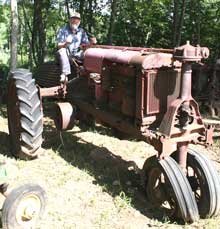Man on a Tractor
In 1947, International Harvester debuted a new logo. Instantly recognizable as the corporation's initials, IH, it was the work of Raymond Loewy, the renowned industrial designer who had already put his stamp on the Gestetner mimeograph machine, the Coldspot refrigerator and the Lucky Strike cigarette package. There was a deeper meaning, however. Given the nickname "Man on a Tractor," the new emblem symbolized a person driving a tricycle-style row crop tractor, the dotted "i" representing the driver's head.
The symbolism was apt. IHC had pioneered the row crop tractor in 1924. Called "Farmall," the new machine ran high off the ground, and was configured so that its wheels fit easily between rows of corn or other agricultural crops. The Farmall, retroactively called the "Regular" once other models were introduced, had a 221 cubic inch ohv four developing 13 horsepower at the drawbar. Most of them had steel wheels. In 1929, IH introduced the F-20 Farmall, named for its drawbar horsepower. It had a more powerful engine and a four-speed transmission, but had the same no-nonsense appearance as its predecessor. Some 136,000 were built before World War II.
In 1932, a smaller version arrived, the F-12 with 12 hp at the drawbar. The F-12, with an economical 113 cubic inch engine and three-speed transmission, was built alongside the F-20. Top of the line was the F-30, actually a 25 hp machine. An intermediate F-14 was produced in 1938 and 1939.
In 1939, all the Farmalls got a makeover. Much the same mechanically, the fashions of the times called for covering up the F-series' exposed innards. Raymond Loewy got the job of devising a tough, yet streamlined package. The result was the classic Farmall that everyone over 50 now remembers, a smooth envelope ending in a rounded fuel tank. The nose was blunt, with a slotted grille.
Models were now identified by letters. The A was a 17-hp machine, four-wheel configuration but offset. A Model B was similar. The mid-range tractor was the H, with 25 hp. At the top was the 33 hp M (diesel version illustrated). A 15-hp C was introduced in 1948. With more horsepower, all but the B were given "Super" prefixes. In 1947, for the rural householder or small farmer, the Cub was introduced. Although the Cub became eponymous, remaining in production until 1979, the other models were replaced with numerically-designated facelifted models, starting in 1954.
My Farmall period started when I was about fourteen and went to work for Bob Frueh at Misty Meadows Farm. His workhorse was a Farmall F-12, in whose seat I spent many hours plowing, harrowing, cultivating, mowing, raking and harvesting. At the Historic Construction Equipment show held in July at the Zagray Farm Museum in Colchester, Connecticut, I was overcome with nostalgia. The Zagray brothers had a fetish about old Farmalls and acquired about 80 of them. The museum has kept a few of them in a Forest of Farmalls. I couldn't resist taking a few minutes to once again be a man on a tractor.

